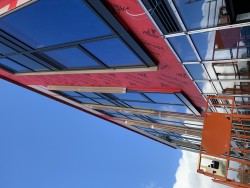Developers turning to offsite construction are installing the Wraptite air barrier system as an essential component in achieving the most effective means of controlling and reducing air leaks and delivering energy efficient homes. Without the correct air barrier protection, the problem of air leakage through cracks, gaps, holes, and improperly sealed elements such as doors and windows cause a significant reduction in the performance of even well-thermally insulated building envelopes.
With the increasing requirements and emphasis on thermal insulation, the proportion of energy lost through air leakage has become more evident. However, thermal insulation will be rendered ineffective unless the airtightness of the structure is addressed. Air leakage dramatically reduces the effect of thermal insulation and must therefore be a critical focus to improve energy efficiency within houses. In addition, energy-efficient heating systems will be ineffective if warm air can escape the building and cold air can seep in.
External vs Internal Air Barrier
The two main ways to achieve airtightness in the building envelope are internally or externally ('inside or outside the services zone'.) In offsite manufacture, the use of traditional internal air barriers can be more complex and costly to install due to the need to accommodate building services such as electrical, lighting, heating, and drainage systems. The internal air barrier is only as good as its installation. If all the service penetrations are not adequately sealed, performance will be compromised.
By moving the air barrier to the external side of the structural frame, external air barrier systems such as Wraptite from A. Proctor Group allow for an almost penetration-free airtight layer that can be installed faster and more robustly. Far simpler than internal options, an external air barrier system like Wraptite will maintain the envelope's integrity, with fewer building services and structural penetrations to be sealed, and less room for error.
Simplifying airtightness
The traditional forms of VCLs and airtightness membranes will often require mechanical fixing. The selfadhered nature of Wraptite allows for a fast and straightforward installation process, minimising the use of additional sealants and tapes and requiring no specialist contractors to achieve a robust result. This one-step solution provides both a damage resistant air barrier layer and effective secondary weather protection in one installation process, allowing a wind and watertight envelope to be achieved more quickly than traditional methods.
Zero carbon homes
The Wraptite external air barrier system has been installed on an exciting low energy homes offsite project for developer Osco Homes. Commissioned by Kirklees Council, the site will demonstrate how high quality, energy-efficient housing can be achieved using offsite construction. The bungalows are designed to be light, spacious, and desirable but must also mitigate fuel poverty and provide a safe and healthy environment where residents can live. The superior airtightness performance of the Wraptite membrane from the A.Proctor Group is the perfect solution, delivering significant benefits to the combination of in-factory manufacture and on-site housing construction.
Gwen Beeken, Managing Director at Osco Homes, described how Wraptite was key to achieving a quality airtightness solution suited to offsite construction, saying: "Although an essential requirement is that the homes had to meet Building Regulations, both the client and OSCO Homes were keen to exceed this. The use of high-quality panels, with a high-performance membrane, built in a factory and assembled on-site, enables OSCO Homes to achieve a better airtightness and higher level of insulation, helping to reduce heating bills. The ease with which Wraptite achieves a high level of airtightness and its ability to be joined across panels was key to its selection.
The Wraptite air barrier system provides a fully self-adhered vapour permeable air barrier certified by the BBA. Wraptite is easily applied in the factory, bonded externally to the substrate, to ensure that the membrane is held firmly in place, even during transportation, maintaining the quality of the system from manufacture, to install, to completion.
For more information visit: www.proctorgroup.com
Read the full article, go to Offsite Magazine









